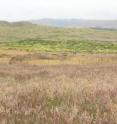Waging war on invasive plant species: Effects of invasives persist even after removal
Related images
(click to enlarge)
Invasive species cost an estimated $1.4 trillion annually in their environmental and economic impacts worldwide and are second only to habitat loss as a threat to biodiversity. As scientists struggle with the challenge of controlling invasive species, the question of why some species are so successful continually arises. Recent research conducted by Dr. Alison Bennett and Dr. Sharon Strauss at the University of California, Davis and Dr. Meredith Thomsen at the University of Wisconsin, La Crosse has shed some light on this complex question. Most previous studies addressing the issue of species success have focused on the effect of individual factors, such as release from native enemies, disturbance, or allelopathy, but the interactions among these factors have not been taken into consideration. Bennett and colleagues investigated the effects of four primary mechanisms that potentially contribute to the success of invasive velvetgrass, Holcus lanatus. Their findings are published in a recent issue of the American Journal of Botany.
Bennett and colleagues focused on the effects of H. lanatus on a native daisy, Erigeron glaucus, at the Bodega Marine Reserve in Bodega Bay, California. In a series of greenhouse and field experiments, these researchers studied the effects of direct competition, changes to the soil community, indirect competition due to changes in herbivore feeding, and interference competition due to allelopathy.
They found that H. lanatus clearly hindered the germination, growth, and establishment of E. glaucus. Bennett and colleagues discovered that direct competition between the two species was responsible for much of the negative impact on E. glaucus. H. lanatus primarily effects E. glaucus due to the dense growth of H. lanatus as well as the dense litter layer and high propagule pressure associated with this invasive species.
"Direct competitive effects of H. lanatus are most important during the invasion process, and they have the greatest effect on plant community structure," Bennett said. "Reduction of the direct competitive effects of H. lanatus should aid in native plant community conservation."
However, Bennett and colleagues also found that the presence of H. lanatus altered soil communities. Due to the overwhelming effects of direct competition, this did not have a large role on the current interactions between H. lanatus and E. glaucus, but these changes likely have a negative impact on E. glaucus and other native species after H. lanatus is removed. Invasive plants are known to affect soil communities as a result of negatively affecting arbuscular mycorrhizal (AM) fungi, which can have damaging impacts on nearby native plants. Holcus lanatus changes the soil AM fungal community in a manner that reduces the benefit of association with AM fungi for E. glaucus, without reducing the benefit for itself. Bennett and colleagues observed a reduction in germination and growth of E. glaucus in soil in which H. lanatus had previously grown, demonstrating that the effects of H. lanatus may linger even after removal of the species.
"Invasive species can strongly influence plant communities while they are present via multiple mechanisms," Bennett commented, "but the effects of invasive species on plant communities can persist long after they have been removed because they can negatively alter soil communities."
This has important implications for mitigating the effects of invasive species. Bennett's future work may focus on how to revert the negative effects of invasive species on soil communities that persist long after the removal of invasive species.
Source: American Journal of Botany
Other sources
- Invasive species: Should we learn to love them?from CBC: Technology & ScienceWed, 10 Aug 2011, 12:30:54 UTC
- Waging war on invasive plant species: Effects of invasives persist even after removalfrom PhysorgWed, 10 Aug 2011, 7:30:24 UTC
- Waging war on invasive plant species: Effects of invasives persist even after removalfrom Science DailyTue, 9 Aug 2011, 21:30:24 UTC
